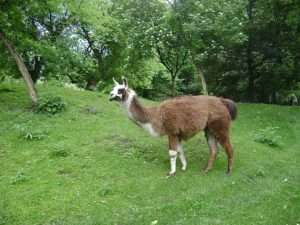 Recently a post crossed my dash on Facebook featuring a small group of llamas in the forests of the Olympic Peninsula. The caption described them as “wild” llamas (Lama glama). That may seem pretty innocuous to the average person, but to a naturalist it’s a gross mischaracterization. For one thing, llamas are completely domestic animals, no more wild than a cow or dog; they are descended from the guanaco (Lama guanacoe), which is a truly wild camelid. So this means that the llamas on the peninsula are feral, not wild. But why does the distinction of wild vs. feral matter so much?
Recently a post crossed my dash on Facebook featuring a small group of llamas in the forests of the Olympic Peninsula. The caption described them as “wild” llamas (Lama glama). That may seem pretty innocuous to the average person, but to a naturalist it’s a gross mischaracterization. For one thing, llamas are completely domestic animals, no more wild than a cow or dog; they are descended from the guanaco (Lama guanacoe), which is a truly wild camelid. So this means that the llamas on the peninsula are feral, not wild. But why does the distinction of wild vs. feral matter so much?
The terms we use to describe various species help us to understand their origin and, perhaps more importantly, their current ecological status. These concepts aren’t just relevant to scientists, however. Everyday people are constantly making decisions that can affect the ecosystems around them, and often these decisions are made without having a full understanding of their impact.
For example, look at how many people release unwanted pets into the wild, whether domesticated rabbits, goldfish, snakes, or other, more exotic animals. Some of these unfortunate animals end up dying pretty awful deaths due to starvation, exposure, or predation. But others manage to survive and reproduce, becoming the latest population of non-native–and potentially invasive–species in their ecosystem. This wouldn’t happen if more people understood the impact of non-native species, and how releasing captive animals puts native species at risk.
But it all starts with knowing that there’s a difference, and understanding the terms that explain why that difference exists. So let’s explore some vocabulary that can be used to describe species, whether animal, plant, or otherwise.
Domesticated vs. Tame
Let’s start with domestication, because there often seems to be confusion as to what makes a species domesticated. Domestication is a process that takes many years, often measured in centuries. Humans breed chosen animals for particular traits over a number of generations. As time passes, each subsequent generation becomes more different from the wild species it originated from, and eventually a new, fully domesticated species emerges from this process of artificial selection by humans.
Dogs (Canis familiaris or Canis lupus familiaris) are the first animal humans domesticated in a process that started about 30,000 years ago. They evolved from the now-extinct Pleistocene wolf, a particular lineage of the gray wolf (Canis lupus), and it’s likely that the partnership began as some wolves showed less fear of humans while scavenging from our kills. By 14,000 years ago dogs were a distinct species (or subspecies) from wolves.
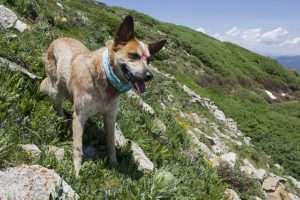 Dogs display very different characteristics from wolves. Their faces tend to be shorter with a more pronounced stop (the bump in the forehead where the muzzle meets the rest of the skull.) Floppy ears and curled tails are common, as are patchy-colored coats. Dogs tend to have weaker muscles than wolves of a similar size, shorter legs and smaller feet, smaller teeth, and a smaller size overall. This is a phenomenon known as neoteny, in which domesticated animals have a tendency to retain more juvenile physical traits of their parent wild species, and you can see it in domesticated animals across the board.
Dogs display very different characteristics from wolves. Their faces tend to be shorter with a more pronounced stop (the bump in the forehead where the muzzle meets the rest of the skull.) Floppy ears and curled tails are common, as are patchy-colored coats. Dogs tend to have weaker muscles than wolves of a similar size, shorter legs and smaller feet, smaller teeth, and a smaller size overall. This is a phenomenon known as neoteny, in which domesticated animals have a tendency to retain more juvenile physical traits of their parent wild species, and you can see it in domesticated animals across the board.
But it’s not just physical appearances that matter. Behaviorally dogs are generally more friendly toward humans; in fact, they’ve even developed some human-friendly body language that wolves don’t have, like “puppy dog eyes.” They can be easily trained and, unless poorly socialized, dogs generally enjoy the company of humans.
In many ways, physically and behaviorally, a dog is a wolf that never grew out of its puppy stage. While a young wolf pup may be able to live in someone’s house for a short time, as they grow older they become more destructive and less tolerant of human company. Your dog may love watching out the window during a car ride, but a wolf is going to be much more stressed out by the experience. Even wolf-dog hybrids have to be treated differently than your average domesticated dog because the wolf content has a significant effect on behavior.
This is just one example of how domestication isn’t just a matter of a few generations of selective breeding. You can also compare domesticated horses (Equus ferus caballus) with Przewalski’s horses (Equus ferus przewalskii or Equus przewalskii) or zebras (subgenus Hippotigris), domesticated cows (Bos taurus) with stories of fierce wild aurochs (Bos primigenius), and so forth. In every case the wild and domesticated counterparts are very different in both appearance and behavior.
Now, what about the term “tame”? Many wild animal species have been tamed over the years, either wild-caught individuals or those born in captivity. These tame animals may be more docile in comparison to their fully wild counterparts, but this generally takes a lot of handling and socialization from a young age. Moreover, tame animals retain a lot more wild behaviors than domesticated ones.
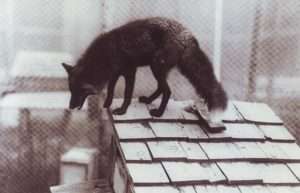 Take those supposed “domesticated” foxes that people want to have as pets. Most of the foxes available as pets have no relation to those in the famous Russian fox domestication experiment, but are from modern fur farm lines. And in fact the study foxes came from Russian fur farms, so the researchers were beginning with pre-tamed animals rather than truly wild ones. While some tame foxes may be more amenable to human handling than wild foxes, they are by no means domesticated. They are more prone to wild behaviors like urinating everywhere to mark territory, chewing on anything they can get their jaws on, nipping, and making a LOT of noise. Moreover, whereas dogs adapted to eating an omnivorous diet after millennia of eating alongside us, foxes need a more specialized diet than what you can get at a pet store.
Take those supposed “domesticated” foxes that people want to have as pets. Most of the foxes available as pets have no relation to those in the famous Russian fox domestication experiment, but are from modern fur farm lines. And in fact the study foxes came from Russian fur farms, so the researchers were beginning with pre-tamed animals rather than truly wild ones. While some tame foxes may be more amenable to human handling than wild foxes, they are by no means domesticated. They are more prone to wild behaviors like urinating everywhere to mark territory, chewing on anything they can get their jaws on, nipping, and making a LOT of noise. Moreover, whereas dogs adapted to eating an omnivorous diet after millennia of eating alongside us, foxes need a more specialized diet than what you can get at a pet store.
Unfortunately there are unscrupulous people within the exotic pet trade who will advertise their tame (at best) stock as “domesticated.” This often leads consumers to thinking that they’re getting a much more tractable animal that will be as easy to care for as a cat or dog, and sets up everyone involved for disaster (except, of course, the seller with a fatter wallet.)
Wild vs. Feral
A wild species is one that has never been domesticated, nor have its ancestors. Generally it will be a native species to its ecosystem, though non-native species can also be introduced to an ecosystem without ever having been domesticated. A feral animal, on the other hand, is a member of a domesticated species that has escaped or been released back into the wild and has survived to reproduce new generations that have never been handled by humans.
 I’ve often heard people refer to the feral swine (Sus domesticus) that have ravaged ecosystems worldwide as “wild pigs”. They may behave in a wild manner, and they certainly look rougher and hairier than your average well-fed domesticated pig on a farm. It’s not uncommon for feral animals to regain some traits of their wild ancestors. However, that does not make them truly wild.
I’ve often heard people refer to the feral swine (Sus domesticus) that have ravaged ecosystems worldwide as “wild pigs”. They may behave in a wild manner, and they certainly look rougher and hairier than your average well-fed domesticated pig on a farm. It’s not uncommon for feral animals to regain some traits of their wild ancestors. However, that does not make them truly wild.
If you manage to wrest away a litter of newborn piglets from a feral sow and bottle-feed them, they are likely to be able to be socialized and kept in captivity, though they may still physically resemble feral pigs. They haven’t lost the deeply-ingrained genes that carry domesticated traits. However, if you try to raise a newborn Eurasian wild boar (Sus scrofa) or red river hog (Potamochoerus porcus), it will lack the domesticated traits of its farm cousins and show more wild traits as it ages, making it a rather unsuitable pet or farm animal. We also see this return to domestic traits in mustangs and other feral horses captured at a young age. While a mustang born in the wild may be tougher to work with at first than a foal born in captivity and handled from birth, the mustang will be much more calm and easier to train than, say, a zebra.
The problem with referring to feral animals as “wild” is that this suggests they are a natural part of the ecosystem they are in. Because a truly domesticated species (or subspecies) is not the same as the parent species, it has no place to which it is native as a wild animal.
Native vs. Non-Native
A native species is one that has evolved in a given ecosystem for thousands or even millions of years. In the process it has developed numerous intricate interrelationships with many other species in that ecosystem, creating a careful system of checks and balances. A non-native species is any species that has been taken out of the ecosystem in which it evolved and placed in a different ecosystem where it is not normally found.
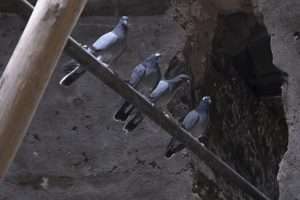 For example, here in North America the mourning dove (Zenaida macroura) is a wild native species. While it may resemble domesticated pigeons, it has never been domesticated even when kept in captivity. The Eurasian collared dove (Streptopelia decaocto), on the other hand, was introduced to the Americas after a few dozen individuals were released in the Bahamas in 1974. The feral pigeon (Columba livia domestica) is a domesticated species derived from the rock dove (Columba livia), which is native to Europe, west Asia, and northern Africa. Both the collared dove and pigeon are examples of non-native species. Most non-native species do not offer any benefits to the ecosystems they are introduced to because they do not have established relationships with native species. When they compete with native species for resources, they weaken the ecosystem overall.
For example, here in North America the mourning dove (Zenaida macroura) is a wild native species. While it may resemble domesticated pigeons, it has never been domesticated even when kept in captivity. The Eurasian collared dove (Streptopelia decaocto), on the other hand, was introduced to the Americas after a few dozen individuals were released in the Bahamas in 1974. The feral pigeon (Columba livia domestica) is a domesticated species derived from the rock dove (Columba livia), which is native to Europe, west Asia, and northern Africa. Both the collared dove and pigeon are examples of non-native species. Most non-native species do not offer any benefits to the ecosystems they are introduced to because they do not have established relationships with native species. When they compete with native species for resources, they weaken the ecosystem overall.
Naturalized vs. Invasive
Non-native species can be further categorized as naturalized or invasive, or even both. A naturalized species is a non-native one that has managed to establish reproducing populations, rather than going extinct without becoming established. Unfortunately, some people take this to mean that the species has become fully integrated into the new ecosystem. However, this is a process that again takes thousands to millions of years as other species adapt to the newcomer, which itself often also changes as it adapts to its new environment.
Ring-necked pheasants (Phasianus colchicus) are an example of a naturalized species in North America. Native to Asia and parts of Europe, they were introduced here as a game bird 250 years ago. While captive pheasants are regularly released into the wild to offer more hunting opportunities to humans, this species has likely been naturalized from its first introduction.
Again, “naturalized” doesn’t mean “natural”. Pheasants compete with native birds like northern bobwhite (Colinus virginianus) and prairie chickens (Tympanuchus spp.) Not only do they compete for food, nesting sites, and other resources, but they also spread diseases to native birds. Pheasants even engage in brood parasitism, laying their eggs in native birds’ nests and sometimes causing the native birds to abandon the nest and their own young entirely.
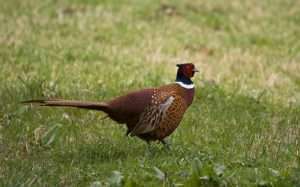 This means that the pheasants are also invasive as well as naturalized. Invasive species are non-natives that aggressively compete with, and sometimes displace or extirpate, native species. There are several hundred species that have become seriously invasive here, including both vertebrate and invertebrate animals, and numerous plants. But even the rest of the over 6000 non-native species that have become naturalized here still put pressure on native species, and have the potential to become invasive if their impact increases to a more damaging point.
This means that the pheasants are also invasive as well as naturalized. Invasive species are non-natives that aggressively compete with, and sometimes displace or extirpate, native species. There are several hundred species that have become seriously invasive here, including both vertebrate and invertebrate animals, and numerous plants. But even the rest of the over 6000 non-native species that have become naturalized here still put pressure on native species, and have the potential to become invasive if their impact increases to a more damaging point.
Hopefully this gives you a clearer understanding of what these terms mean and why it’s important to know the difference. By knowing a little more about how your local ecosystem works and how different species may be contributing to or detracting from its overall health, you have more power to be able to make decisions that can preserve native species and help ecosystems be more resilient. Given that the removal of invasive species is one of the most important ways we can help ecosystems thrive in spite of climate change, it’s more important than ever that we increase nature literacy among the general populace. Consider this article just one small way to move that effort along.

Interesting that I happened upon this article just moments after asking a fellow naturalist if a particular “new” bird species to our area is feral or invasive. It’s endemic to Asia, we are in Northern California, and it has just made an appearance in our area this winter. It made me want to dive down that rabbit-hole of naturalist research about the terms. Thank you for an informative article! I am a certified California Naturalist who feels the need to be outdoors daily, Sonoma County just north of San Francisco. Have a great day!
Glad you had a chance to add a rarity to your life list!
Hi Rebecca,
Just a slight Pleistocene bone to pick with your article. Camelids are from the Americas and Guancao/llama-esque species as well as a species more similar to Bactrian and Dromedary Camels, both roamed in much of what is the United States and in Canada. I think some species (not all) should be considered for reintroduction. Even Feral llamas are not so foreign to the USA’s natural landscape as your article seems to suggest, however, the Olympic Peninsula is not ideal for them and Gaunacos would be better in a suitable habitat. Oh and yes, I consider Mustangs to be a reintroduced species. I’m in that camp. Fine article though.
Thanks for your perspective! There’s a big question with regards to rewilding as to how much an ecosystem changes in the time since a particular taxon went extinct in a particular region. Camelops species were extinct by about 11,000 years ago, which is about when most of the rest of North America’s megafauna went extinct. That is a not-insignificant time for an ecosystem to adjust, at least somewhat, to the loss of these species, along with changes in local and regional climates.
Moreover, two species being similar doesn’t automatically mean that they will have identical ecological impacts on an ecosystem. Look at cattle vs. bison; this paper does a good job of outlining how they are not really ecological analogues. Domestication can significantly change a species’ behavior and its connection to an ecosystem; llamas are, of course, domesticated descendants of guanacos, and so are not direct analogues to their wild ancestors, either. Since we do not have living Camelops to compare to extant camelid species, it should not be automatically assumed that either Old World or New World camelids would be close enough ecological analogues to Camelops to be safely reintroduced. I would much rather see the reintroduction of extant large herbivores like the bison, pronghorn, and various native cervids, as well as their native predators, and observe how that effects the overall ecosystem before we even consider adding in extant relatives of long-extinct species.